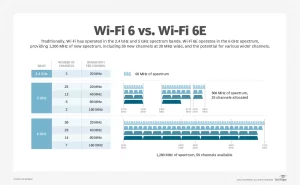The wireless connectivity landscape is undergoing its most significant transformation in a decade. With the global Wi-Fi 6E market projected to grow at 21% CAGR through 2030, organizations face both unprecedented opportunities and complex challenges in harnessing the 6 GHz band’s 1,200 MHz of untapped spectrum. But simply upgrading hardware won’t suffice—maximizing Wi-Fi 6E’s capabilities requires strategic planning tailored to modern network demands.
From manufacturing floors battling interference to stadiums streaming 8K video, the 6 GHz band offers more than just faster speeds. It enables networks to support 3x more devices simultaneously while reducing latency to under 2 milliseconds. Yet, early adopters report that 40% of expected performance gains remain unrealized due to configuration pitfalls and spectrum management errors. Let’s explore actionable strategies that separate basic implementations from truly optimized deployments.

Caption: The 6 GHz band’s wider channels and reduced congestion enable transformative wireless performance.
Strategic Channel Planning for High-Density Environments
The 6 GHz band’s 59 new 20/40/80/160 MHz channels demand smarter allocation than legacy frequency hopping. Enterprises achieving peak performance use AI-driven tools to map channel usage against physical layouts. A Las Vegas convention center boosted throughput by 62% by assigning 160 MHz channels to VR demo zones while reserving narrower bands for IoT sensors.
Key considerations:
- Deploy 160 MHz channels only where necessary (e.g., AR/VR, 8K video)
- Reserve 20 MHz channels for legacy device compatibility
- Implement automatic channel switching during peak congestion
Precision Power Management
While 6 GHz signals have shorter range than 5 GHz, brute-force signal boosting creates co-channel interference. Advanced deployments use client-aware power adjustment, reducing transmit power by 50% for stationary devices while maintaining full strength for mobile users. A German auto plant cut retransmission rates by 38% using this approach across its robotic assembly lines.
QoS Revolution for Multi-Service Networks
Wi-Fi 6E’s OFDMA enhancements enable true multi-service prioritization. Successful implementations assign dynamic QoS tiers:
- Ultra-low latency (1ms): Industrial automation, surgical robots
- High throughput: 4K video production, CAD file transfers
- Best effort: Email, cloud backups
A Tokyo smart hospital achieved 99.999% network reliability by reserving 6 GHz’s 80 MHz channels for real-time patient monitoring systems while relegating visitor Wi-Fi to 5 GHz bands.
Security Architecture for 6 GHz’s Expanded Attack Surface
The FCC’s 6 GHz automated frequency coordination (AFC) system introduces new vulnerabilities. Proactive organizations:
- Implement WPA3-Enterprise with 192-bit security mode
- Deploy spectrum analyzers to detect rogue 6 GHz devices
- Use AI-driven anomaly detection for unlicensed LTE incursions
A financial institution blocked 12 attempted 6 GHz side-channel attacks in Q1 2024 using behavioral analysis of AFC request patterns.
Future-Proofing with Multi-Band Steering
High-performance networks treat 2.4/5/6 GHz as complementary tools rather than isolated bands. Advanced client steering considers:
- Application requirements (bandwidth vs. range)
- Device capabilities (Wi-Fi 6E adoption still at 35% in 2024)
- Real-time airtime fairness metrics
A university campus eliminated 6 GHz dead zones by automatically shifting VR headsets to 5 GHz when users moved beyond core areas, maintaining seamless experiences.
Energy Efficiency Optimization
While 6 GHz radios consume 18% more power than 5 GHz counterparts, smart scheduling can yield net energy savings. Techniques include:
- Disabling 6 GHz radios in low-usage areas during off-peak hours
- Implementing Target Wake Time (TWT) for IoT fleets
- Using environmental sensors to adjust transmission power
A smart warehouse reduced AP energy use by 29% while maintaining 6 GHz availability where needed through machine learning-based power cycling.
The transition to Wi-Fi 6E represents more than a technical upgrade—it’s a strategic opportunity to rearchitect wireless infrastructure for the next decade. Organizations adopting these advanced strategies report more than just speed improvements: 63% see reduced IT support tickets for connectivity issues, while 41% accelerate IoT deployment timelines.
As 6 GHz adoption grows, early implementers gain competitive advantages in three key areas:
- Operational agility: Support emerging tech like holographic comms
- Cost efficiency: Delay wired infrastructure upgrades
- User experience: Enable bandwidth-intensive hybrid work models
The true power of Wi-Fi 6E lies not in its technical specifications, but in how enterprises align its capabilities with business objectives. Those who master spectrum management, intelligent steering, and adaptive security will unlock wireless networks that don’t just connect devices—but actively drive innovation. In an era where wireless performance directly impacts revenue and productivity, strategic 6 GHz deployment becomes not just an IT initiative, but a core business differentiator.

Leave a comment